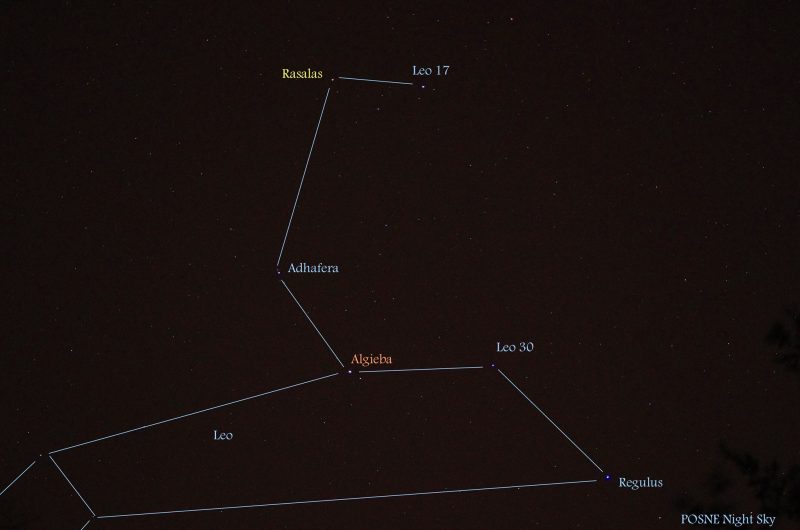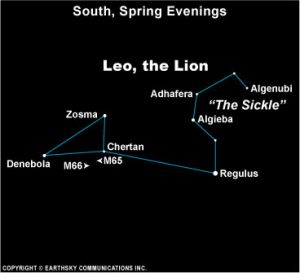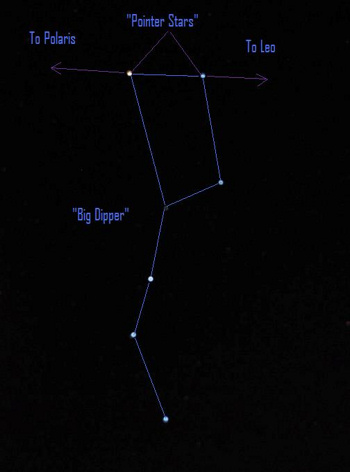

Constellation Leo. Photo via Dennis Chabot of POSNE NightSky.
Of the 13 constellations of the zodiac, Leo the Lion ranks as one of the easiest to identify in the night sky. Most people find Leo by looking first for a distinctive pattern on the sky’s dome: the pattern of a backwards question mark. That star pattern – or asterism – is called the Sickle in Leo. Leo’s brightest star, Regulus, marks the bottom of the backwards question mark pattern. Read the sections below to learn more about the constellation Leo.

Leo the Lion.
How to see the constellation Leo.
From a Northern Hemisphere perspective, the Lion is a fair-weather friend, springing into the early evening sky around the March equinox. Late March, April and May are superb months for identifying Leo the Lion, as this constellation becomes visible as soon as darkness falls and stays out until the wee hours of the morning. Remember, you are looking for a backwards question mark pattern. This pattern is the Sickle; its curve outlines the Lion’s mane. Leo’s brightest star, Regulus, is a sparkling blue-white beauty of a star. It’s located at the bottom of the backwards question mark pattern and depicts the Lion’s heart.
A triangle of stars in eastern Leo represents the Lion’s hindquarters and tail. The brightest star of the triangle is named Denebola, which stems from an Arabic term meaning the Lion’s Tail.
Like all stars, Leo’s stars return to the same place in the sky some four minutes earlier daily or two hours earlier monthly. In early April, the constellation Leo reaches its high point for the night around 10 p.m. local time (11 p.m. local daylight saving time), and starts to sink below the western horizon around 4 a.m. local time (5 a.m. local daylight saving time). By around May 1, Leo reaches his high point for the night around 8 p.m. local time (9 p.m. local daylight saving time). Also, in early May, the mighty Lion begins to set in the west around 2 a.m. local time (3 a.m. daylight saving time). By June, you’ll find Leo descending in the west in the evening.
Though Leo drifts progressively westward in the early evening sky as the months go by, the Lion can be viewed in the evening till July. By late July or early August, the Lion begins to fade into the sunset, not to return to the eastern predawn sky until late September or October.

An imaginary line drawn between the pointer stars in the Big Dipper – the two outer stars in the Dipper’s bowl – points in one direction toward Polaris, the North Star, and in the opposite direction toward Leo.
Find Leo by star-hopping from the Big Dipper.
If you’re familiar with the Big Dipper asterism, you can star-hop to Leo the Lion every time. To find Leo, first find the Big Dipper. In March, the Big Dipper stands pretty much on its handle in the northeast sky at nightfall. At nightfall in April, look for the Big Dipper higher in the northeast sky, and at nightfall in May, look for the upside-down Big Dipper high in the north, above Polaris, the North Star. Then identify the two pointer stars of the Big Dipper – that is, the two outer stars in the Big Dipper’s bowl. An imaginary line drawn between these stars points in one direction toward Polaris, the North Star. And it points in the opposite direction toward Leo.

Image via Urania’s Mirror.
Constellation Leo in history and myth.
Leo the Lion has long been associated with the sun. The sun passes in front of the constellation Leo the Lion from about August 10 to September 16 each year. The ancient Egyptians held Leo in the highest esteem, because the sun shone in front of this constellation at the time of the annual flooding of the Nile River, the lifeblood of this agricultural nation.
It’s thought that the various lion-headed fountains designed by Greek and Roman architects symbolize the life-giving waters being released by the sun’s presence in Leo.
In astrology, Leo – one of the three fire signs of the Zodiac – is ruled by the sun.
Many stories are associated with Leo the Lion. Perhaps the two better-known tales feature Hercules’ first labor with the notorious Nemean Lion, and the Roman author Ovid’s rendering of the tragic love affair of Pyramus and Thisbe.

Image via Wikimedia Commons.
What can you see with a telescope in Leo?
Check out the chart above to get a sense of the telescopic riches that lie within the boundaries of this constellation.
The star Algieba is a double star, visible in a small telescope when the atmosphere is steady. If the stars are twinkling wildly, that indicates a turbulent – not steady – atmosphere. On the other hand, if the stars are twinkling very little or not at all, try your luck at splitting Algieba – which looks like a single star to the eye – into its two colorful component stars with the telescope.
A close-knit pair of galaxies in Leo also provide an inviting target for the telescope: M65 and M66. With a low-powered telescope, you might be able fit both M65 and M66 into a single field of view.
Once you have done performed that feat, try your luck with the other galaxy pair: M95 and M96.
Bottom line: The constellation Leo the Lion is east to overhead on spring evenings. How to find Leo and more on the constellation.
Taurus? Here’s your constellation
Gemini? Here’s your constellation
Cancer? Here’s your constellation
Leo? Here’s your constellation
Virgo? Here’s your constellation
Libra? Here’s your constellation
Scorpius? Here’s your contellation
Sagittarius? Here’s your constellation
Capricornus? Here’s your constellation
Aquarius? Here’s your constellation
Pisces? Here’s your constellation
Aries? Here’s your constellation
Birthday late November to early December? Here’s your constellation




















